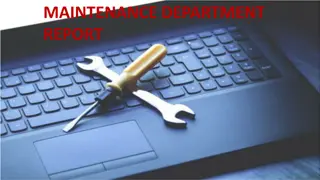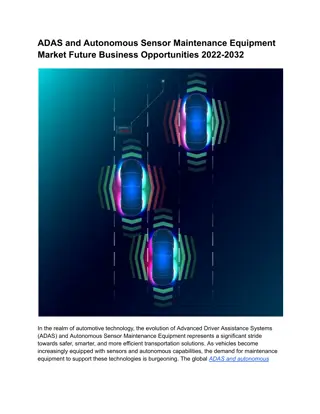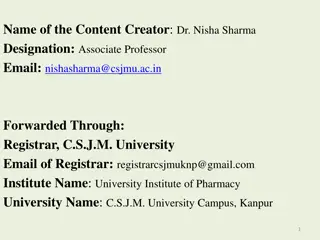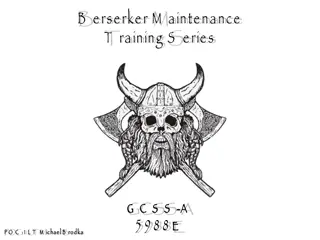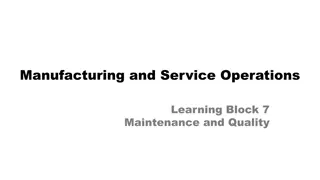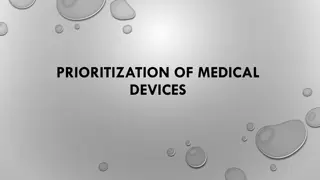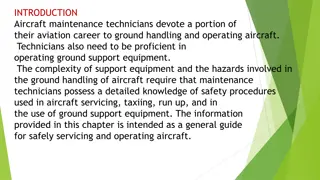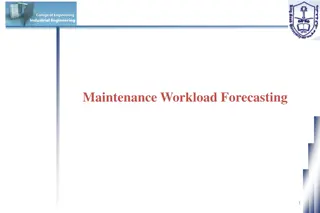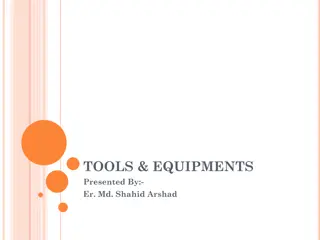Understanding DA Form 5988-E for Equipment Maintenance
The DA Form 5988-E is divided into three sections: Equipment Data, Parts Requested, and Maintenance Faults. It is essential for identifying a vehicle's status, tracking parts orders, and recording faults. Regular updates and proper documentation are crucial to ensure the form reflects the current condition of the equipment. The form is integral for maintenance crews to perform PMCS and log any faults for each subsystem. Understanding the battalion equipment numbering system and following SOP guidelines is key to effectively using DA Form 5988-E for maintenance tasks.
Download Presentation

Please find below an Image/Link to download the presentation.
The content on the website is provided AS IS for your information and personal use only. It may not be sold, licensed, or shared on other websites without obtaining consent from the author. Download presentation by click this link. If you encounter any issues during the download, it is possible that the publisher has removed the file from their server.
E N D
Presentation Transcript
Maintenance DA 5988-E The data on DA Form 5988-E is divided into three sections. EQUIPMENT DATA The top section of the form gives basic information from the ULLS- G equipment data file and maintenance master data file. The main purpose of this data is to identify the vehicle. PARTS REQUESTED This section identifies all parts on order for the vehicle. The document control register in ULLS-G reflects this information also. MAINTENANCE FAULTS This section shows a list of vehicle faults from the ULLS-G maintenance fault file. This includes all uncorrected faults for the equipment. This is where the driver also enters any new faults found during PMCS inspection.
The date in the upper left corner is the date the form was printed. Your unit SOP will give an interval for updating the form. If your unit SOP requires the form be updated once a week, then the date must not be older than a week old. The vehicle crew must know the current status of repair parts requested and previously reported faults. The most important thing DA Form 5988-E does is to show equipment status, but to do this, it must be current. An outdated form may not give the current vehicle status. Besides routine updates, update the form immediately when vehicle mission capable status changes.
You should have the battalion equipment numbering system as part of the SOP. For example, if someone told you that D2S is not mission capable, how would you know what part of the system is affected? Per the SOP, the "S" means that it is a weapon system; however, if the SOP stated that all M240 machine guns will use the administration number suffix "S," then you would also know the weapon subsystem model. The "S" is used as an example only; your SOP may use other suffixes. The DA Form 5988-E is kept in the equipment record folder. There must be a form for each reportable item of equipment in the system. The crew must perform PMCS for each subsystem supporting the equipment's role to shoot, move, and communicate. In most cases, there will be more than one form in the record folder since the crew must prepare a separate form on each subsystem. When the PMCS is done, it is recorded on the DA Form 5988-E with the same administration number as the vehicle. The vehicle administration number is the bumper number.
The lower two sections of the form list repair parts and equipment faults. When an operator discovers a fault that is not correctable at operator level, it is written on the form just below the last entry. The next several examples will walk you through finding faults, recording them on the DA Form 5988-E, and updating the form when the faults are corrected.
Look at this DA Form 5988-E carefully. It represents a perfect vehicle. There are no faults noted so no repair parts are required. You will probably never see a form like this again. Let's assume that during the before- operations PMCS on 7 Aug 96 that no new faults are found. The operator enters the date the before- operations PMCS was completed in the FAULT DESCRIPTION column to indicate that a before-operations PMCS was conducted and no faults were found.
After the before-operations PMCS are complete, the operator makes the during- operations PMCS while the vehicle is operated and at halts. At the conclusion of the day's operation, the driver must perform the after-operations PMCS. After the during- and after- operations PMCS are complete, the operator enters his driver license number in the OPER LIC# column. This DA Form 5988- E for vehicle D2 indicates that the after-operations PMCS are complete and no new faults were found. There must be a new entry for each day the vehicle is operated and no new fault is reported. The same form can be used until the form is updated or a new fault is reported.
On 8 Aug 96, the operator of vehicle D2 discovers new faults and lists them on DA Form 5988- E as indicated on the adjacent form. The driver may enter the new faults at the bottom of the form if the equipment is not going to be dispatched; otherwise, the new faults must be entered on DA Form 2404 or a DA Form 5988-E continuation sheet. The operator discovered the faults during the before- operations PMCS because there is no date in the fault description column to indicate that the before-operations PMCS were completed on 8 Aug 96. After entering the new faults on the form, the operator's driver license number is entered in the INSPECTORS LIC# block. The ITEM NUM is the PMCS check number from the TM -10. The numbers will be in ascending order if the driver performed the PMCS in TM sequence.
This is DA Form 2404. It is a manual form used to report new equipment faults. The main difference between this form and the DA Form 5988-E is that the operator must complete the form heading on the DA Form 2404; otherwise, the form is the same. The operator enters the date in the lower part of the form when the before-operations PMCS are completed and no new faults area found. The operator also initials the right column of the form when no new faults are discovered in during- and after-operations PMCS. When new faults are discovered, the operator enters usage in block 4 and the date in block 5 at the top of the form and signs the form. The operator must give the signed and dated form to his immediate supervisor and start a new form.
The ULLS-G computer produces the DA Form 5988- E continuation sheet. It may be used to report new faults when the vehicle is dispatched. When the ULLS-G clerk updates DA Form 5988- E, the system will print another DA Form 5988-E continuation sheet if requested. The advantage of this form over the DA Form 2404 is that the driver does not have to prepare the form heading, and the form is always available as long as the unit has a printer.
Maintenance leader Course Daily PMCS Fault Status When the operator must report a fault, a fault status symbol must be assigned to the fault. There are three symbols the operator can use: -The "X" WITHACIRCLED TM ITEMNUMBER indicates a deficiency that causes the vehicle to be NMC. -The slash (/) indicates a shortcoming (minor fault). -The dash (--) indicates the vehicle is overdue a normal modification work order (MWO).
Look at the fault recorded for TM item 2. This is a serious fault, called a deficiency, as is indicated by the "X" status symbol. -The driver knew to enter an NMC status for the TM item number 2 fault because the PMCS checklist EQUIPMENT IS NOT READY/AVAILABLE IF (right) column listed the condition ENGINE TEMP GA INOP as a not ready/available condition.
AR 385-55, Prevention of Motor Vehicle Accidents, shows the regulatory guidance concerning the administrative or safety deadlining of equipment. Commanders will: 1. Include safety training in operator qualification. 2. Ensure PMCS is accomplished before, during, and after operations. 3. Ensure that no administratively deadlined vehicle is operated. Equipment is administratively or safety deadlined for improper function or condition of these components: Windshield, windshield wipers, steering, lights, horns, signals, mirrors, restraint system, tires, wheel hubs, tie down straps, sharp sheet metal, exhaust systems, reflectors, safety devices. Equipment is NMC if: Any gasoline, Class III oil, diesel, or coolant leak exists. Parking/service brakes are inoperable or out of adjustment.
AR 385-55 lists lights as a safety deficiency. The vehicle is unsafe to dispatch without lights. Lights, however, do not affect the vehicle's ability to do its combat mission. A / status safety deficiency from AR 385- 55 that is not listed in the TM - 10 as a NOT READY/AVAILABLE IFcondition does not count as NMC time. You must make sure that drivers have the information from AR 385-55 to decide if the equipment is safe to operate; the TM -10 does not provide this information. When the operator finds new faults to report, as in this case, the form is given to the immediate supervisor for review before it goes to unit maintenance.




